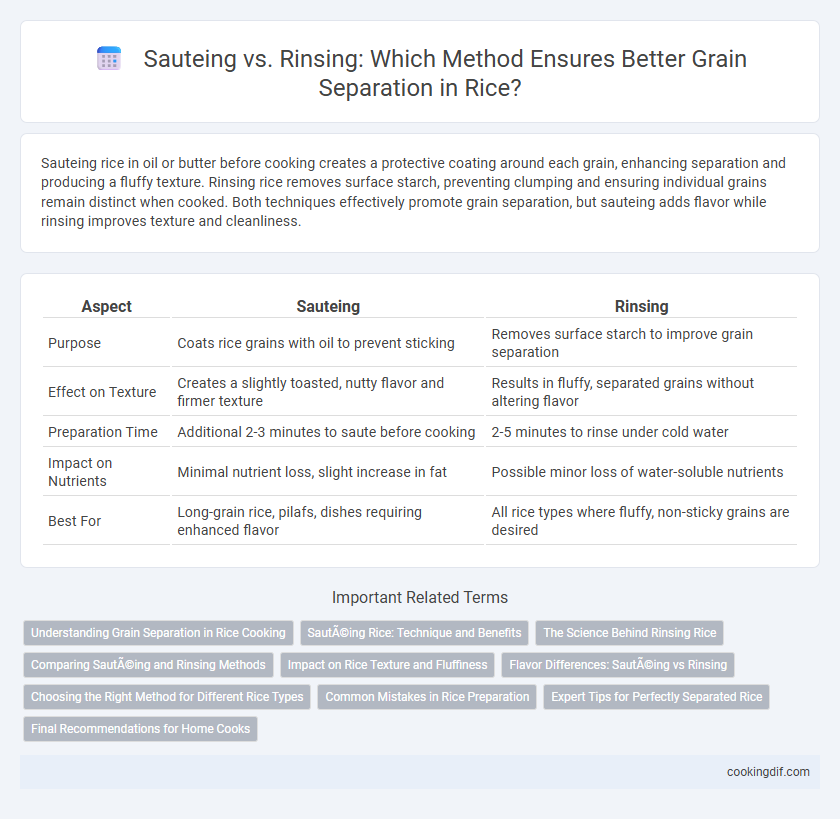Sauteing rice in oil or butter before cooking creates a protective coating around each grain, enhancing separation and producing a fluffy texture. Rinsing rice removes surface starch, preventing clumping and ensuring individual grains remain distinct when cooked. Both techniques effectively promote grain separation, but sauteing adds flavor while rinsing improves texture and cleanliness.
Table of Comparison
| Aspect | Sauteing | Rinsing |
|---|---|---|
| Purpose | Coats rice grains with oil to prevent sticking | Removes surface starch to improve grain separation |
| Effect on Texture | Creates a slightly toasted, nutty flavor and firmer texture | Results in fluffy, separated grains without altering flavor |
| Preparation Time | Additional 2-3 minutes to saute before cooking | 2-5 minutes to rinse under cold water |
| Impact on Nutrients | Minimal nutrient loss, slight increase in fat | Possible minor loss of water-soluble nutrients |
| Best For | Long-grain rice, pilafs, dishes requiring enhanced flavor | All rice types where fluffy, non-sticky grains are desired |
Understanding Grain Separation in Rice Cooking
Sauteing rice grains before cooking enhances separation by coating each grain with oil, preventing clumping and promoting a fluffy texture. Rinsing rice removes excess surface starch, reducing stickiness but can also wash away some nutrients and flavor. Effective grain separation depends on balancing rinsing to reduce starch with sauteing to maintain grain integrity and texture.
Sautéing Rice: Technique and Benefits
Sauteing rice in oil or butter before cooking enhances grain separation by coating each grain, which reduces stickiness and promotes a fluffy texture. This technique mildly toasts the rice, developing a nutty flavor and improving its overall aroma and taste. It is particularly effective for long-grain varieties like basmati and jasmine, where distinct grains are preferred.
The Science Behind Rinsing Rice
Rinsing rice removes surface starch that causes grains to stick together during cooking, promoting better grain separation and a fluffier texture. The water washes away excess amylopectin, a starch molecule responsible for the gummy consistency in unrinsed rice. In contrast, sauteing rice before cooking coats grains with oil or fat, which can also reduce stickiness but does not remove starch, resulting in different texture and flavor profiles.
Comparing Sautéing and Rinsing Methods
Sauteing rice before cooking enhances grain separation by coating kernels with oil, preventing clumping and promoting a fluffy texture. Rinsing rice removes surface starch, reducing stickiness but may lead to nutrient loss and requires careful drying to maintain grain integrity. Comparing these methods, sauteing optimizes texture through fat absorption, while rinsing prioritizes starch removal for cleaner, less sticky grains.
Impact on Rice Texture and Fluffiness
Sauteing rice in oil or butter before cooking creates a protective coating around each grain, resulting in a firmer texture and enhanced fluffiness by preventing clumping. Rinsing rice removes excess surface starch, reducing stickiness and promoting grain separation for a lighter, fluffier final dish. Combining rinsing with sauteing optimizes texture by balancing starch removal and grain coating, yielding fluffy, well-separated rice grains.
Flavor Differences: Sautéing vs Rinsing
Sauteing rice in oil or butter enhances its nutty flavor and creates a slightly toasted aroma, which adds depth to the final dish. Rinsing rice removes excess surface starch but can also wash away some of the rice's natural nuttiness, resulting in a cleaner but less complex flavor. Choosing sauteing over rinsing emphasizes richer taste profiles, while rinsing prioritizes texture and grain separation.
Choosing the Right Method for Different Rice Types
Sauteing rice in oil or butter creates a protective coating around grains, preventing clumping and enhancing flavor, ideal for long-grain varieties like basmati or jasmine. Rinsing rice removes excess surface starch, crucial for short-grain and sticky rice types to achieve fluffy, separate grains after cooking. Selecting between sauteing and rinsing depends on rice morphology and desired texture, ensuring optimal grain separation and culinary results.
Common Mistakes in Rice Preparation
Sauteing rice before cooking can enhance flavor but commonly results in uneven grain separation if done with excessive oil or high heat. Rinsing rice removes surface starch, crucial for preventing clumping, yet over-rinsing may wash away essential nutrients like iron and B vitamins. A balanced approach combining gentle rinsing and controlled sauteing ensures fluffy, well-separated grains without compromising nutritional value.
Expert Tips for Perfectly Separated Rice
Rinsing rice removes excess surface starch, preventing grains from sticking together and resulting in a fluffier texture. Sauteing rice in oil or butter before cooking coats each grain, creating a barrier that further enhances separation and adds a nutty flavor. Expert chefs recommend combining both methods--rinsing thoroughly and lightly sauteing--to achieve perfectly separated, non-clumpy rice ideal for pilafs and fried rice dishes.
Final Recommendations for Home Cooks
For achieving optimal grain separation in cooked rice, sauteing grains in oil or butter before boiling creates a light coating that reduces stickiness and enhances flavor. Rinsing rice thoroughly under cold water removes excess surface starch, preventing clumping and resulting in fluffier texture. Home cooks seeking the best results should prioritize rinsing for clean, separate grains, while incorporating a brief sauteing step for added richness and improved mouthfeel.
Sautéing vs Rinsing for grain separation Infographic

 cookingdif.com
cookingdif.com